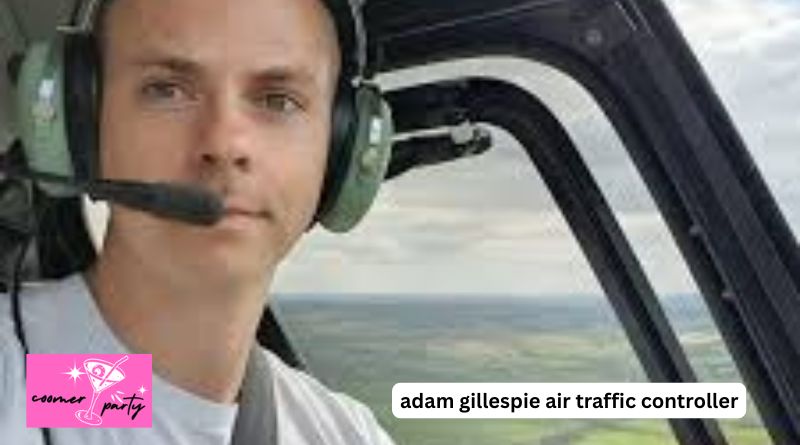Beginning: The Man Who Made the Radar
Air traffic controllers are the unsung heroes of the aviation sector. They make sure that thousands of flights take off and land safely every day, even when the pressure is on. Behind the radar displays and quick orders is a very human narrative of focus, tension, ambition, and, at times, quiet suffering. One of these stories is about Adam Gillespie, a talented and hard-working air traffic controller whose bright career came to an end too soon. His story is a compelling reminder that even the best and most skilled professionals require care, support, and room to breathe.
A Dream from Childhood Under the Flight Path
Adam grew up in Norfolk, where planes weren’t just background noise; they were interesting. As a child, he would sit for hours with his father beside the airstrip and watch jets take off into the clouds. That childish sense of wonder gradually turned into a clear goal. He studied aeronautical engineering because he wanted to assist keep planes safe from the ground one day.
Adam wasn’t like most people who just fall into their jobs; he knew exactly what he wanted and worked hard to get it. He went on to one of the UK’s most difficult air traffic control training programs after getting his degree. He learned everything from how to deal with bad weather to how to communicate under great pressure. This wasn’t simply a job for Adam; it was a calling.
Life in the Control Tower: Master of the Skies
Air traffic control isn’t glamorous, but it’s really important. Adam had to coordinate dozens, and occasionally hundreds, of planes on every shift. He had to pay close attention, make decisions right away, and be perfect at timing. One misstep could lead to disaster. But Adam did well in this setting.
Before his shift each morning, he got to work early to check the weather, system warnings, and traffic forecasts. He checked the communication systems, read the NOTAMs, and was ready in his mind for what might happen. Adam stayed calm, collected, and very focused, whether he was handling inbound flights in a storm or rerouting jets because of difficulties.
People who worked with him remember his voice on the radio: clear, confident, and calming. Pilots had faith in him. Other controllers looked up to him. He had the uncommon capacity to make things quiet when they were out of control.
A Leader and Lifelong Learner Beyond the Console
Adam wasn’t simply good at his job; he also had a great attitude. He always wanted to learn more, so he went to workshops, volunteered for emergency simulations, and mentored junior controllers. He thought it was important to not just do his work well, but also help other people do theirs better.
He worked well with others, too. Adam’s willingness to work with others made him a silent leader at a place where one person’s error might affect the whole system. He didn’t want to be in the spotlight. He really wanted everyone to do well and come home safely.
He was also very interested in the future of air traffic control and came up with suggestions for how to automate and improve the system. He said, “We can’t automate human judgment, but we can use technology to give us more time to make the right choice.” His way of doing things was based on that mix of rationality and empathy.
The Hidden Stress: What You Don’t See
Even though he was very good at his job, the stress got to him. One of the most demanding occupations in the world is air traffic control. A lot of time. A lot at stake. Always being on guard. Adam dealt with it for years with strength and determination. But with time, that weight got heavier.
He started to show signs of burnout, like trouble sleeping, increased anxiety, and emotional exhaustion. He didn’t think much of it at first. He didn’t like to complain. But it was getting harder to ignore the signs. After a lot of thought in 2022, Adam took the hard choice to leave the profession he loved. It was brave, not weak.
A New Chapter: Looking for Peace in Simple Things
Adam didn’t stop trying just because he left air traffic control. It meant he put his health first, which is something a lot of people forget to do. He got a job as a cleaner at Downtide Caravans and Leisure in Norfolk because he wanted to live a peaceful life. The job was easy, physical, and didn’t have the same high demands as his last one. For a while, it made him feel better.
Adam was honest about his mental health journey. He talked about it with his partner, Henri Andrews-Buller, and tried to find serenity after years of living in a high-stress workplace. But it wasn’t simple to get used to life outside the tower. It was hard to find someone else who could fill the role he had constructed for himself—steady, bright, and important.
He continued trying, though. Friends and family said he was a kind, ambitious, and compassionate person who still dreamed of starting over, maybe even going back to work in aviation in a new job eventually.
October 28, 2023, was a sad day
Henri found Adam unresponsive at their house in Hainford, Norfolk, on a calm Saturday morning in late October. He had used a bondage collar previously and it had worked fine, but this time he was alone himself. Sadly, the collar made it hard for him to breathe. Even though emergency personnel got very promptly, they couldn’t save Adam. He was only 29 years old.
The coroner said that the person died because of “constriction of neck structures” and that it was a “misadventure,” which means it was a tragic accident and not something that was done on purpose. The inquest, which took place in June 2025, showed that Adam had been interested in BDSM before, but he knew it was dangerous. The warnings on the goods made it obvious that these things should not be utilized alone.
His family, however heartbroken, made it clear that Adam died loved and supported. He had ideas. He had hope. His death wasn’t a sign of hopelessness; it was a warning that accidents, particularly in private, need to be taken very seriously.
Adam’s Legacy: More Than a Number
The story of Adam Gillespie is about more than simply flying, mental health, or tragedy. It’s about all of it. It’s about how talented people can carry difficulties that aren’t obvious. How even people who rescue lives every day could need help themselves. It’s about having the right to choose change. And heartbreak over how quickly life may end.
His death has led to talks in many areas:
His contemporaries in aviation want more mental health help for people who are retiring or changing careers.
His experience in mental health shows how important it is to recognize burnout and make treatment commonplace without making people feel bad about it.
His accident has made people more aware of how to utilize adult gear safely and how important it is to never do risky things alone.
A Note for the Future
Every radar ping, safety lesson, and smooth landing is a reminder that there is a person behind it all with ideas, dreams, problems, and wants. It tells us to check in with ourselves and with the people who seem strongest on the outside.
Adam’s story gives young professionals who are just starting out in high-pressure areas some quiet advice:
Learn how to execute your job well, but don’t let it take over your life.
Ask for help now, not later.
Taking a break isn’t a sign of weakness. It’s wise.
Final Thoughts: Showing Kindness to Adam’s Memory
Adam Gillespie‘s legacy is one of professionalism, generosity, and bravery. He was a calming voice in the control tower and a compassionate presence at home. He lived a meaningful life, and even after he died, he still teaches us about safety, being vulnerable, and the deep worth of compassion.
May his memory soar with the planes he used to fly—steady, attentive, and free.

